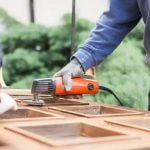Before painting woodwork, it is crucial to thoroughly clean the surfaces to ensure a smooth and long-lasting finish. Cleaning woodwork before painting not only helps remove dust, dirt, grease, grime, and stains but also prepares the surface for optimal paint adhesion. By prepping the woodwork properly, you can achieve a flawless finish that enhances the overall appearance of your home.
Prepping woodwork surfaces before painting is essential as it allows the paint to adhere better and prevents potential issues such as peeling or bubbling. Any dust or debris on the surface can interfere with paint application and result in an uneven finish. Additionally, grease, grime, and stains can create a barrier between the paint and the wood, leading to poor adhesion.
Cleaning woodwork surfaces before painting has numerous benefits. Not only does it create a smooth canvas for painting, but it also improves the durability of the paint job. By removing dirt and contaminants from the woodwork, you ensure that the paint adheres firmly and doesn’t chip or peel easily over time. A clean surface also helps prevent any imperfections from showing through the paint, resulting in a professional-looking finish.
In order to properly clean woodwork before painting, it is important to understand the nature of different types of surfaces commonly found in homes. Different woods have varying characteristics and may require specific cleaning methods or products. By knowing what type of woodwork you have, you can choose appropriate cleaning techniques to effectively remove any buildup or stains without damaging the surface.
In summary, cleaning woodwork surfaces before painting is a crucial step in achieving a successful paint job. Proper prepping ensures that the paint adheres well and creates a durable finish that enhances your home’s aesthetics. Understanding the nature of different woodwork surfaces and gathering necessary tools are essential steps to efficiently clean them before applying fresh coats of paint. These efforts will pay off with a flawless finish that adds value and beauty to your living space.
Understanding the nature of woodwork surfaces
Woodwork surfaces can vary in their composition and characteristics, and it is essential to understand these nuances before attempting to clean them. Different types of woodwork surfaces are commonly found in homes, including trim, baseboards, doors, and window frames. Each of these surfaces may have different finishes or coatings that require specific cleaning methods.
When it comes to woodwork surfaces, it is crucial to know the type of wood that has been used. Some common types of wood used in homes include pine, oak, maple, and cherry. Each type of wood has its own unique properties, such as hardness, grain pattern, and susceptibility to damage.
To choose the appropriate cleaning method for woodwork surfaces, it is essential to determine if they are painted or stained. Painted woodwork surfaces can generally be cleaned with a mild detergent solution and a soft cloth or sponge. On the other hand, stained woodwork surfaces require more careful handling to avoid damaging the finish.
To identify the type of coating on a woodwork surface, look for visible signs such as paint chips or peeling areas. If the surface appears glossy or has a sheen, it is likely painted. If there are variations in color or visible grain patterns, it is likely stained.
Once you have determined the type of woodwork surface you are dealing with and its coating or finish, you can proceed with confidence in choosing the appropriate cleaning method. By understanding the nature of your woodwork surfaces, you can ensure that they will be properly cleaned and prepared for painting.
Gathering the necessary tools and supplies
List of Essential Tools and Supplies
Before starting the process of cleaning woodwork surfaces before painting, it is essential to gather the necessary tools and supplies. Having all the required items at hand will ensure a smooth and efficient cleaning process. Here are some of the essential tools and supplies you will need:
- Soft-bristle brush: Choose a brush with soft bristles to avoid scratching or damaging the woodwork surfaces. A brush with fine bristles is ideal for removing dust, dirt, and debris from intricate detailing or hard-to-reach areas.
- Microfiber cloth: Microfiber cloths are excellent for capturing dust particles and absorbing cleaning solutions. They are gentle on delicate woodwork surfaces and leave behind minimal lint residue.
- Vacuum cleaner with brush attachment: A vacuum cleaner equipped with a brush attachment allows you to remove loose dust and debris efficiently. The brush attachment helps agitate particles embedded in crevices or grain patterns, ensuring thorough cleaning.
- Compressed air canister or blower: Compressed air canisters or blowers are useful for blowing away stubborn dust particles from hard-to-reach nooks and crannies in woodwork surfaces. Be sure to follow safety instructions when using compressed air as it can be harmful if not handled properly.
- Mild detergent or soap solution: Mix a mild detergent or soap with warm water to create a gentle cleaning solution suitable for most woodwork surfaces. Avoid using harsh chemicals that can damage or discolor the wood.
- White vinegar: White vinegar is an excellent natural cleaner that effectively removes grease and grime from woodwork surfaces without leaving behind any residue. Mix equal parts of white vinegar and water for a simple yet effective solution.
Detailed Explanations and Recommendations
- Soft-bristle brushes are important because they help minimize scratches on the woodwork surface during cleaning. Hard-bristle brushes may leave visible marks or damage the wood, leading to an unsightly finish.
- Microfiber cloths are recommended because they are soft and non-abrasive. They effectively trap dust and dirt particles, preventing them from spreading or being reintroduced onto the surface during cleaning.
- Vacuum cleaners with brush attachments are highly recommended for removing loose debris from woodwork surfaces. The brush attachment helps to agitate and dislodge stubborn particles that may be embedded in the crevices or grain patterns of the wood.
- Compressed air canisters or blowers are particularly useful for areas that are difficult to access, such as intricate carvings or tight corners. The powerful burst of air effectively removes dust and debris that cannot be reached by brushes or vacuum cleaners alone.
- When mixing a mild detergent or soap solution for cleaning woodwork surfaces, choose products specifically designed for delicate surfaces. Avoid using abrasive cleaners as they can strip away finishes or cause discoloration.
- White vinegar is an excellent natural cleaner for removing grease and grime from woodwork surfaces. It is gentle yet effective and does not leave behind any residue. However, it is important to do a spot test in an inconspicuous area before using vinegar on the entire surface to ensure compatibility with the type of woodwork.
By gathering these essential tools and supplies, you will be well-equipped to effectively clean your woodwork surfaces before painting, ensuring a smooth and durable paint finish.
Removing dust and debris from woodwork surfaces
Here are some effective techniques for removing dust and debris:
- Dusting: Start by using a soft cloth or a duster to gently remove loose dust from the surface of the woodwork. Make sure to reach into corners, crevices, and other hard-to-reach areas.
- Vacuuming: Use a brush attachment on your vacuum cleaner to gently vacuum the woodwork surfaces. This will help remove any remaining loose dust particles that may have been missed during dusting.
- Compressed air: If there are stubborn areas where dust is difficult to remove, you can use compressed air to blow away the particles. Be cautious when using compressed air and follow the manufacturer’s instructions to prevent any damage to the woodwork or yourself.
Remember, it is important not to skip this step or rush through it, as even small particles of dust can affect the final outcome of your paint job. Taking the time to thoroughly clean the woodwork surfaces will ensure better adhesion of the paint and result in a smoother finish.
In addition to removing dust, it is also important to address any larger debris such as cobwebs or loose paint flakes before painting. These can be removed with a soft brush or by lightly sanding the affected areas.
By following these steps for removing dust and debris, you will be well on your way to achieving a flawless finish on your woodwork surfaces when painting. Taking the time and effort for proper preparation will yield long-lasting results that you can enjoy for years to come.
Removing grease and grime from woodwork surfaces
Identifying common grease and grime stains on woodwork and their sources
Before diving into the cleaning process, it is crucial to identify the types of grease and grime stains commonly found on woodwork surfaces. Grease stains can come from sources such as cooking oil splatters, fingerprints, or body oils transferred from hands. Grime stains, on the other hand, can result from everyday dust and dirt buildup or even pet dander. It is essential to understand the sources of these stains as it can help determine the most effective cleaning method.
Offering step-by-step instructions on how to remove grease and grime using gentle yet effective cleaning solutions
When it comes to removing grease and grime from woodwork surfaces, it is essential to use gentle yet effective cleaning solutions. Harsh chemicals can damage or discolor the wood, so opting for milder options is recommended. One option is a mixture of warm water and mild dish soap.
This solution can be applied using a soft cloth or sponge to gently scrub away grease and grime. For particularly stubborn stains, a paste made from baking soda and water can be used as a natural abrasive cleaner.
Another homemade remedy for removing grease and grime involves combining equal parts vinegar and water. This solution works well for cutting through tough buildup while also being safe for use on most types of woodwork surfaces. Simply mix the vinegar and water in a spray bottle, then lightly mist onto the stained areas before wiping clean with a cloth.
Implementing preventive measures against future grease and grime buildup
Once the current grease and grime stains have been successfully removed from woodwork surfaces, it is important to take preventive measures to minimize future buildup. Regularly wiping down woodwork with a dry microfiber cloth can help prevent dust particles from accumulating, thus reducing opportunities for greasy substances to stick to the surface. Additionally, using coasters or placemats on wood surfaces can protect against spills and stains from beverages or food.
By understanding the nature of grease and grime stains, utilizing gentle yet effective cleaning solutions, and implementing preventive measures, you can successfully remove these unsightly marks from your woodwork surfaces. Preparing the woodwork in this way ensures a smooth and clean canvas for your paint job and contributes to a more professional-looking finish.
Dealing with stains on woodwork surfaces
Woodwork surfaces are prone to various types of stains, from water-based spills to tough ink or marker marks. It is important to properly deal with these stains before painting to ensure a smooth and flawless finish. Understanding the type of stain and using appropriate cleaning methods can help effectively remove them without damaging the woodwork.
When dealing with water-based stains, such as beverage spills or water rings, it is crucial to act quickly. Start by blotting up any excess liquid using a clean cloth or paper towel. Then, mix a solution of mild dish soap and warm water.
Dip a soft cloth into the soapy solution and gently rub the stained area in a circular motion. Avoid scrubbing vigorously, as this may damage the wood. Afterward, wipe off the soapy residue with a damp cloth, and dry the area thoroughly.
For oil-based stains like ink or marker marks, there are several effective methods for removal. One option is to use rubbing alcohol or denatured alcohol on a cotton ball or soft cloth. Dab the stained area with the alcohol-soaked cotton ball and gently rub in circular motions until the stain starts to dissolve.
Another method involves creating a paste using baking soda and water. Apply the paste to the stain and let it sit for about 10 minutes before gently rubbing it away with a soft cloth.
By following these steps and using appropriate cleaning methods, you can effectively remove different types of stains from woodwork surfaces before painting. This ensures that your paint will adhere properly and result in a professional-looking finish.
| Stain Type | Cleaning Method |
|---|---|
| Water-Based Stains (e.g., beverage spills) | – Blot up excess liquid
|
| Oil-Based Stains (e.g., ink or marker marks) | – Use rubbing alcohol on cotton ball or soft cloth
|
Preparing woodwork for painting
Properly preparing woodwork surfaces before painting is essential to achieving a professional and long-lasting paint job. This section will discuss the importance of surface preparation and provide techniques for getting woodwork surfaces ready for painting.
One of the key steps in preparing woodwork for painting is sanding. Sanding helps to smooth out any imperfections on the surface, creating a more even and receptive canvas for paint. It also helps to remove any existing paint or varnish that may be chipping or peeling.
Before sanding, it is important to ensure that the woodwork surface is clean and free from dust and debris. This can be done using a vacuum or compressed air as discussed in the previous section.
Once the surface has been thoroughly cleaned, begin sanding by using a medium-grit sandpaper (around 120 to 150 grit) to remove any roughness or uneven areas. Sand in the direction of the grain, being careful not to apply too much pressure that could damage the wood. After sanding with the medium-grit sandpaper, switch to a fine-grit sandpaper (around 220 grit) to further smooth out the surface. This will help create a smooth finish for your paint.
In addition to sanding, it may be necessary to fill any holes, gaps, or cracks in the woodwork surface before painting. Use a suitable wood filler or putty that matches your woodwork and follow the manufacturer’s instructions for application. Once applied, allow it to dry completely before sanding it down flush with the surrounding surface.
To further enhance adhesion and durability, it is recommended to prime your woodwork surfaces before applying paint. Primer creates a protective barrier between the bare wood and the paint, ensuring better color coverage and longer-lasting results. Choose an appropriate primer based on your specific needs (e.g., water-based or oil-based primer) and apply it according to the manufacturer’s instructions.
By properly preparing your woodwork surfaces through sanding, filling, and priming, you will create a solid foundation for your paint job. This will result in a smoother finish and extend the longevity of your painted woodwork. Remember to always follow safety precautions while preparing woodwork for painting, such as wearing protective gear and working in a well-ventilated area.
| Essential Tools | Recommended Supplies |
|---|---|
| Sandpaper (medium-grit and fine-grit) | Wood filler or putty |
| Sanding block or electric sander | Primer (water-based or oil-based) |
| Vacuum or compressed air | Paintbrushes or rollers |
| Tack cloth or lint-free cloth | Drop cloths or plastic sheeting |
Choosing the right cleaning products for woodwork surfaces
When selecting cleaning products for woodwork surfaces, it is important to consider their compatibility with different types of wood and any previous treatments that may be present. For example, if the woodwork has been previously varnished or stained, it is important to choose a cleaner that is safe for use on these finishes. Water-based cleaners are generally safe for most types of wood finishes and are effective at removing dirt and grime.
For tougher stains or oily residue on woodwork surfaces, specialized cleaners may be required. It’s important to select cleaners that are specifically designed to tackle grease and grime without damaging the woodwork. These cleaners often contain solvents that help break down oils and remove stubborn stains.
Many people also prefer using eco-friendly and non-toxic cleaning products when working with wooden surfaces due to concerns about indoor air quality and environmental impact. There are numerous natural options available such as vinegar-based cleaners or citrus-based cleaners that effectively clean without harsh chemicals.
Overall, choosing the right cleaning product for woodwork surfaces depends on understanding the specific requirements of the surface being cleaned and the desired outcome. It is always a good idea to test any new product on a small inconspicuous area before applying it to the entire surface to ensure compatibility and prevent any potential damage. With proper research and consideration, selecting the appropriate cleaning product will contribute greatly to achieving a clean and ready-to-paint woodwork surface.
Final cleaning steps and precautions
Once you have completed the initial steps of removing dust, dirt, grease, grime, and stains from your woodwork surfaces in preparation for painting, there are a few final cleaning steps and precautions to keep in mind. These additional measures will help ensure that your woodwork is properly cleaned before painting and will contribute to achieving a flawless finish.
Firstly, it is important to do a thorough inspection of the woodwork surfaces to make sure that all debris and contaminants have been effectively removed. Take a close look at corners, crevices, and hard-to-reach areas to ensure that no residue remains. Use a flashlight if necessary to aid in seeing any lingering dirt or stains. If you notice any missed spots or stubborn stains, go back and address them before proceeding with painting.
Next, it is crucial to protect surrounding areas from any potential spills or splatters during the cleaning process. Cover nearby furniture, flooring, or other surfaces with drop cloths or plastic sheets to prevent accidental damage from cleaning solutions or water. Additionally, consider using painter’s tape on adjacent walls or trim to create clean edges and avoid unintentionally spreading cleaning agents onto areas where they are not needed.
As with any cleaning task, it is essential to prioritize safety by using appropriate protective gear. When working with cleaning solutions or solvents, wear gloves to protect your hands from potential irritants or allergic reactions. Depending on the type of cleaner being used, you may also need safety goggles or a face mask to shield yourself from fumes or airborne particles. Always read the labels on cleaning products carefully and follow the manufacturer’s instructions for safe use.
By following these final cleaning steps and taking necessary precautions, you can ensure that your woodwork surfaces are thoroughly cleaned before painting. This attention to detail will help you achieve a flawless finish and extend the longevity of your paint job. With clean and well-prepared woodwork surfaces as your canvas, you can now proceed with confidence to the next step of your painting project.
Conclusion
In conclusion, the importance of properly cleaning woodwork surfaces before painting cannot be overstated. Prepping these surfaces is crucial for achieving a flawless finish and extending the longevity of your paint job. By following the outlined steps and recommendations, you can ensure a smoother and more durable result.
Thoroughly understanding the nature of woodwork surfaces is essential in selecting the appropriate cleaning method. Different types of woodwork have their own characteristics and require specific tools and supplies. By gathering the necessary tools and supplies beforehand, you will be well-prepared to clean and prepare your woodwork surfaces effectively.
Removing dust, debris, grease, grime, and stains from woodwork surfaces is a critical step in achieving a professional finish. Dust particles and build-up can negatively impact the adhesion of paint, while grease, grime, and stains can lead to uneven texture or discoloration on your painted surface.
By utilizing proven techniques for removing these substances, such as dusting, vacuuming, using compressed air, or employing gentle cleaning solutions for grease and grime removal, you can ensure a clean and smooth surface ready for paint.
Lastly, it is important to consider proper surface preparation techniques like sanding, filling holes, and priming before painting woodwork surfaces. These steps will further enhance adhesion and improve the overall visual appeal of your final paint job. Additionally, selecting the right cleaning products that are compatible with your type of woodwork surface is crucial for minimizing damage or adverse reactions.
Frequently Asked Questions
Can you use rubbing alcohol to clean wood before painting?
While rubbing alcohol can be used to clean wood before painting, it is not always the best choice. Rubbing alcohol is highly effective at removing dirt, grease, and grime from various surfaces. However, when it comes to preparing wood for painting, it may not provide the optimal results.
This is because rubbing alcohol can potentially dry out the wood and strip away some of its natural oils, leading to potential damage or poor paint adhesion. Instead, it is often recommended to use a dedicated wood cleaner or degreaser specifically designed for this purpose.
What can you use to clean surface before painting?
When preparing a surface for painting, there are several options available for cleaning. The choice of cleaning agent depends on the specific type of surface being painted and the type of contaminants present on it. For general cleaning purposes, mild soap and water can be effective in removing dirt and grime from most surfaces.
However, if there are grease or oil stains present, a more potent degreaser may be required. In some cases, abrasive cleaners or sanding may also be necessary to ensure a smooth and clean surface before painting. It is essential to read and follow the manufacturer’s instructions when selecting a cleaning agent suitable for the specific surface being painted.
Is acetone or alcohol better for paint prep?
Both acetone and alcohol can be used for paint preparation, but their effectiveness depends on several factors. Acetone is a strong solvent that is highly effective at lifting oil-based paints and varnishes from surfaces. It evaporates quickly without leaving residue behind, making it an excellent choice for stripping old paint layers or stubborn coatings. On the other hand, alcohol (such as denatured alcohol or rubbing alcohol) is typically used to clean surfaces before painting by removing grease, dirt, and light contaminants without damaging the underlying material or finish.
It evaporates more slowly than acetone but leaves less residue behind. Ultimately, choosing between acetone or alcohol for paint prep depends on the specific requirements of the project, the type of paint or finish being removed, and the surface being cleaned. It is always advisable to test a small inconspicuous area first before applying these solvents to larger areas.

Hi everyone! I’m a woodworker and blogger, and this is my woodworking blog. In my blog, I share tips and tricks for woodworkers of all skill levels, as well as project ideas that you can try yourself.





